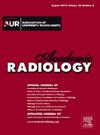用于预测胃肠道间质瘤 Ki-67 增殖指数的次区域 CT 放射线组学:一项多中心研究
IF 3.8
2区 医学
Q1 RADIOLOGY, NUCLEAR MEDICINE & MEDICAL IMAGING
引用次数: 0
摘要
理由和目标目的是评估和检查造影剂增强 CT 导出的放射组学模型对病理证实的胃肠道间质瘤(GIST)患者的 Ki-67 增殖指数(PI)的亚区域放射组学预测能力:在这项回顾性研究中,三家机构共招募了 412 名 GIST 患者(223 名来自第一中心,106 名来自第二中心,83 名来自第三中心)。采用K-means方法从感兴趣的肿瘤区域的不同子区域得出放射学特征。采用最小绝对收缩和选择操作器(LASSO)回归法来识别与 GIST 患者 Ki-67 PI 水平相关的特征。然后,利用训练队列中每个子区域的放射组学特征,构建了一个支持向量机(SVM)模型来预测 Ki-67 的高水平(Ki-67 指数大于 8%):结果:经过特征选择过程,得到了 6、9、9、7 个特征,分别构建了基于子区域 1、2、3 和整个肿瘤的 SVM 模型。在不同的模型中,子区域 1 建立的模型在训练集、外部测试集 1 和 2 中的接收者操作特征曲线下面积(AUC)分别为 0.880(95% 置信区间 [CI]:0.830 至 0.919)、0.852(95% CI:0.770 至 0.914)、0.799(95% CI:0.697 至 0.879):本研究结果表明,基于亚区域放射组学特征的 SVM 模型具有预测 GIST 患者 Ki-67 PI 水平的潜力。本文章由计算机程序翻译,如有差异,请以英文原文为准。
Sub-regional CT Radiomics for the Prediction of Ki-67 Proliferation Index in Gastrointestinal Stromal Tumors: A Multi-center Study
Rationale and Objectives
The objective was to assess and examine radiomics models derived from contrast-enhanced CT for their predictive capacity using the sub-regional radiomics regarding the Ki-67 proliferation index (PI) in patients with pathologically confirmed gastrointestinal stromal tumors (GIST).
Methods
In this retrospective study, a total of 412 GIST patients across three institutions (223 from center 1, 106 from center 2, and 83 from center 3) was enrolled. Radiomic features were derived from various sub-regions of the tumor region of interest employing the K-means approach. The Least Absolute Shrinkage and Selection Operator (LASSO) regression was employed to identify features correlated with Ki-67 PI level in GIST patients. A support vector machine (SVM) model was then constructed to predict the high level of Ki-67 (Ki-67 index > 8%), drawing on the radiomics features from each sub-region within the training cohort.
Results
After features selection process, 6, 9, 9, 7 features were obtained to construct SVM models based on sub-region 1, 2, 3 and the entire tumor, respectively. Among different models, the model developed by the sub-region 1 achieved an area under the receiver operating characteristic curve (AUC) of 0.880 (95% confidence interval [CI]: 0.830 to 0.919), 0.852 (95% CI: 0.770–0.914), 0.799 (95% CI: 0.697–0.879) in the training, external test set 1, and 2, respectively.
Conclusion
The results of the present study suggested that SVM model based on the sub-regional radiomics features had the potential of predicting Ki-67 PI level in patients with GIST.
求助全文
通过发布文献求助,成功后即可免费获取论文全文。
去求助
来源期刊

Academic Radiology
医学-核医学
CiteScore
7.60
自引率
10.40%
发文量
432
审稿时长
18 days
期刊介绍:
Academic Radiology publishes original reports of clinical and laboratory investigations in diagnostic imaging, the diagnostic use of radioactive isotopes, computed tomography, positron emission tomography, magnetic resonance imaging, ultrasound, digital subtraction angiography, image-guided interventions and related techniques. It also includes brief technical reports describing original observations, techniques, and instrumental developments; state-of-the-art reports on clinical issues, new technology and other topics of current medical importance; meta-analyses; scientific studies and opinions on radiologic education; and letters to the Editor.
 求助内容:
求助内容: 应助结果提醒方式:
应助结果提醒方式:


